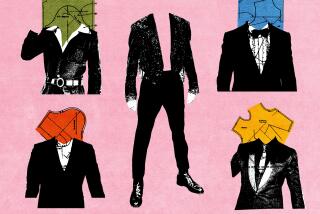Collar This Culprit and Lock It Away
- Share via
For Washington men, the button-down shirt is a bad habit that will not die. And heaven knows that, in most cases, it should.
As daily hordes of bureaucrats emerge from offices, one can’t help but be struck by their unflagging loyalty to button-down shirts. These oxford-cloth garments are favored by those recently graduated as well as those close to retirement. Its fans are culturally diverse, demographically varied and stylistically indifferent.
The mushy collar, the persnickety little buttons, the inevitably broken threads along the neckline all conjure up images of hapless college graduates trying to make a good impression on a prospective employer. Rote, unimaginative style--this is what the button-down shirt has been reduced to thanks to constant wearing and willful abuse. It is donned with reckless disregard for whether the soft, casual collar is flattering to jowly jawlines, long, scrawny necks or angular faces.
“Button-down shirts look geeky, uptight, and will make even the newest suit look slightly stale,” write Hal Rubenstein and Jim Mullen in “Paisley Goes With Nothing: A Man’s Guide to Style.”
*
This is the heart of the problem: These are sporty shirts being worn with business attire.
The origins of the shirts lie on England’s polo fields. The collars of polo shirts buttoned so they would not flap in the breeze when a player charged across the field on his mount. A version of this buttoning collar was introduced in the United States at the turn of the century by Brooks Brothers.
The shirt was originally tailored out of oxford cloth and was favored on the golf course, the tennis court and the polo field. Many consider the Brooks Brothers original button-down shirt to be an American fashion classic. Its collar rolls just so, the cuffs are just the right width and, of course, it has a distinguished lineage. At the time of its introduction, when most shirt collars were formal and stiff, this easy and informal one was a startling departure.
*
The shirt’s appeal grew thanks, in large part, to Fred Astaire. With his rakish demeanor and wealth of panache, he took to wearing button-down shirts with gray flannel suits, pinstriped styles and double-breasted ones, says New York-based menswear designer and author Alan Flusser. Astaire turned the button-down shirt into a statement of innovation, adventure and individualism.
The button-down shirt now has little to do with aesthetics. If it did, there would be far fewer frayed, rumpled and ill-fitting versions lumbering around. Instead, as informality has infiltrated every aspect of life, the collars have gotten lower, droopier and almost universally disastrous when paired with a tie.
“Most men wear button-downs because that’s what their bosses wear and what their compatriots wear,” Flusser says. “Most people are wearing clothes they grew up with.”
Button-down collars would not be so unfortunate if men wore the shirts casually, with a pair of chinos perhaps, or with a sport jacket.
But no. Men insist on wearing button-down-collar shirts with the most formal suits and the dressiest ties.
Men who have been hailed for their ability to connote authority with their clothes--Vernon Jordan, Colin Powell, Warren Christopher--wear crisp shirts with respectable spread collars. Knowledge being power, they know this:
Button-down collars are not dressy.






